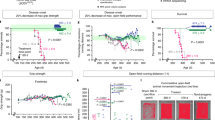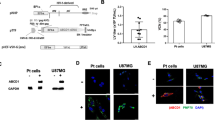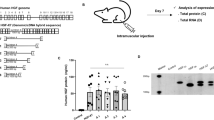Abstract
We examined integrase-defective lentiviral vectors (IDLVs) with a mutant (D64V) integrase in terms of their residual integration capability, the levels and duration of transgene expression and their therapeutic potential in comparison to wild-type lentiviral vectors (WTLVs) with a wild-type integrase gene. Compared with WTLVs, the IDLV-mediated proviral integration into host-cell chromosomes was approximately 1/3850 in HeLa cells and approximately 1/111 in mouse cerebellar neurons in vivo. At 2 months, transgene expression by IDLVs in the mouse cerebellum was comparable to that by WTLVs, but then significantly decreased. The mRNA levels at 6 and 12 months after injection in IDLV-infected cerebella were approximately 26% and 5%, respectively, of the mRNA levels in WTLV-injected cerebella. To examine the therapeutic potential, IDLVs or WTLVs expressing a molecule that enhances the ubiquitin-proteasome pathway were injected into the cerebella of spinocerebellar ataxia type 3 model mice (SCA3 mice). IDLV-injected SCA3 mice showed a significantly improved rotarod performance even at 1 year after-injection. Immunohistochemistry at 1 year after injection showed a drastic reduction of mutant aggregates in Purkinje cellsfrom IDLV-injected, as well as WTLV-injected, SCA3 mice. Our results suggest that because of the substantially reduced risk of insertional mutagenesis, IDLVs are safer and potentially effective as gene therapy vectors.
This is a preview of subscription content, access via your institution
Access options
Subscribe to this journal
Receive 12 print issues and online access
$259.00 per year
only $21.58 per issue
Buy this article
- Purchase on Springer Link
- Instant access to full article PDF
Prices may be subject to local taxes which are calculated during checkout




Similar content being viewed by others
References
Lever AM, Strappe PM, Zhao J . Lentiviral vectors. J Biomed Sci 2004; 11: 439–449.
Apolonia L, Waddington SN, Fernandes C, Ward NJ, Bouma G, Blundell MP et al. Stable gene transfer to muscle using non-integrating lentiviral vectors. Mol Ther 2007; 15: 1947–1954.
Kulkosky J, Skalka AM . Molecular mechanism of retroviral DNA integration. Pharmacol Ther 1994; 61: 185–203.
Hindmarsh P, Leis J . Retroviral DNA integration. Microbiol Mol Biol Rev 1999; 63: 836–843; table of contents.
Hacein-Bey-Abina S, Von Kalle C, Schmidt M, McCormack MP, Wulffraat N, Leboulch P et al. LMO2-associated clonal T cell proliferation in two patients after gene therapy for SCID-X1. Science 2003; 302: 415–419.
Li Z, Dullmann J, Schiedlmeier B, Schmidt M, von Kalle C, Meyer J et al. Murine leukemia induced by retroviral gene marking. Science 2002; 296: 497.
Matrai J, Chuah MK, VandenDriessche T . Recent advances in lentiviral vector development and applications. Mol Ther 2010; 18: 477–490.
Banasik MB, McCray PB Jr . Integrase-defective lentiviral vectors: progress and applications. Gene Therapy 2010; 17: 150–157.
Bayer M, Kantor B, Cockrell A, Ma H, Zeithaml B, Li X et al. A large U3 deletion causes increased in vivo expression from a nonintegrating lentiviral vector. Mol Ther 2008; 16: 1968–1976.
Lombardo A, Genovese P, Beausejour CM, Colleoni S, Lee YL, Kim KA et al. Gene editing in human stem cells using zinc finger nucleases and integrase-defective lentiviral vector delivery. Nat Biotechnol 2007; 25: 1298–1306.
Nightingale SJ, Hollis RP, Pepper KA, Petersen D, Yu XJ, Yang C et al. Transient gene expression by nonintegrating lentiviral vectors. Mol Ther 2006; 13: 1121–1132.
Philippe S, Sarkis C, Barkats M, Mammeri H, Ladroue C, Petit C et al. Lentiviral vectors with a defective integrase allow efficient and sustained transgene expression in vitro and in vivo. Proc Natl Acad Sci USA 2006; 103: 17684–17689.
Saenz DT, Loewen N, Peretz M, Whitwam T, Barraza R, Howell KG et al. Unintegrated lentivirus DNA persistence and accessibility to expression in nondividing cells: analysis with class I integrase mutants. J Virol 2004; 78: 2906–2920.
Yanez-Munoz RJ, Balaggan KS, MacNeil A, Howe SJ, Schmidt M, Smith AJ et al. Effective gene therapy with nonintegrating lentiviral vectors. Nat Med 2006; 12: 348–353.
Qin Q, Inatome R, Hotta A, Kojima M, Yamamura H, Hirai H et al. A novel GTPase, CRAG, mediates promyelocytic leukemia protein-associated nuclear body formation and degradation of expanded polyglutamine protein. J Cell Biol 2006; 172: 497–504.
Torashima T, Koyama C, Iizuka A, Mitsumura K, Takayama K, Yanagi S et al. Lentivector-mediated rescue from cerebellar ataxia in a mouse model of spinocerebellar ataxia. EMBO Rep 2008; 9: 393–399.
Leavitt AD, Robles G, Alesandro N, Varmus HE . Human immunodeficiency virus type 1 integrase mutants retain in vitro integrase activity yet fail to integrate viral DNA efficiently during infection. J Virol 1996; 70: 721–728.
Vatakis DN, Kim S, Kim N, Chow SA, Zack JA . Human immunodeficiency virus integration efficiency and site selection in quiescent CD4+ T cells. J Virol 2009; 83: 6222–6233.
Nakajima N, Lu R, Engelman A . Human immunodeficiency virus type 1 replication in the absence of integrase-mediated dna recombination: definition of permissive and nonpermissive T-cell lines. J Virol 2001; 75: 7944–7955.
Sawada Y, Kajiwara G, Iizuka A, Takayama K, Shuvaev AN, Koyama C et al. High transgene expression by lentiviral vectors causes maldevelopment of Purkinje cells in vivo. Cerebellum 2010; 9: 291–302.
Liu B, Wang S, Brenner M, Paton JF, Kasparov S . Enhancement of cell-specific transgene expression from a Tet-Off regulatory system using a transcriptional amplification strategy in the rat brain. J Gene Med 2008; 10: 583–592.
Hioki H, Kuramoto E, Konno M, Kameda H, Takahashi Y, Nakano T et al. High-level transgene expression in neurons by lentivirus with Tet-Off system. Neurosci Res 2009; 63: 149–154.
Kobayashi K, Yasuhara T, Agari T, Muraoka K, Kameda M, Ji Yuan W et al. Control of dopamine-secretion by Tet-Off system in an in vivo model of parkinsonian rat. Brain Res 2006; 1102: 1–11.
Sloan B, Scheinfeld N . The use and safety of doxycycline hyclate and other second-generation tetracyclines. Expert Opin Drug Saf 2008; 7: 571–577.
Vandenberghe LH, Auricchio A . Novel adeno-associated viral vectors for retinal gene therapy. Gene Therapy 2012; 19: 162–168.
Weinberg MS, Samulski RJ, McCown TJ . Adeno-associated virus (AAV) gene therapy for neurological disease. Neuropharmacology 2013; 69: 82–88.
Lentz TB, Gray SJ, Samulski RJ . Viral vectors for gene delivery to the central nervous system. Neurobiol Dis 2012; 48: 179–188.
Stieger K, Schroeder J, Provost N, Mendes-Madeira A, Belbellaa B, Le Meur G et al. Detection of intact rAAV particles up to 6 years after successful gene transfer in the retina of dogs and primates. Mol Ther 2009; 17: 516–523.
Niemeyer GP, Herzog RW, Mount J, Arruda VR, Tillson DM, Hathcock J et al. Long-term correction of inhibitor-prone hemophilia B dogs treated with liver-directed AAV2-mediated factor IX gene therapy. Blood 2009; 113: 797–806.
Terashima T, Miwa A, Kanegae Y, Saito I, Okado H . Retrograde and anterograde labeling of cerebellar afferent projection by the injection of recombinant adenoviral vectors into the mouse cerebellar cortex. Anat Embryol 1997; 196: 363–382.
Iino M, Goto K, Kakegawa W, Okado H, Sudo M, Ishiuchi S et al. Glia-synapse interaction through Ca2+-permeable AMPA receptors in Bergmann glia. Science 2001; 292: 926–929.
Duale H, Kasparov S, Paton JF, Teschemacher AG . Differences in transductional tropism of adenoviral and lentiviral vectors in the rat brainstem. Exp Physiol 2005; 90: 71–78.
Hartman ZC, Appledorn DM, Amalfitano A . Adenovirus vector induced innate immune responses: impact upon efficacy and toxicity in gene therapy and vaccine applications. Virus Res 2008; 132: 1–14.
Johnson WG . Late-onset neurodegenerative diseases—the role of protein insolubility. J Anat 2000; 196 (Part 4): 609–616.
Nagai Y, Popiel HA . Conformational changes and aggregation of expanded polyglutamine proteins as therapeutic targets of the polyglutamine diseases: exposed beta-sheet hypothesis. Curr Pharm Des 2008; 14: 3267–3279.
Seidel K, Siswanto S, Brunt ER, den Dunnen W, Korf HW, Rub U . Brain pathology of spinocerebellar ataxias. Acta Neuropathol 2012; 124: 1–21.
Williams A, Jahreiss L, Sarkar S, Saiki S, Menzies FM, Ravikumar B et al. Aggregate-prone proteins are cleared from the cytosol by autophagy: therapeutic implications. Curr Top Dev Biol 2006; 76: 89–101.
Hegde AN, Upadhya SC . Role of ubiquitin-proteasome-mediated proteolysis in nervous system disease. Biochim Biophys Acta 2011; 1809: 128–140.
Takalo M, Salminen A, Soininen H, Hiltunen M, Haapasalo A . Protein aggregation and degradation mechanisms in neurodegenerative diseases. Am J Neurodegen Dis 2013; 2: 1–14.
Niwa H, Yamamura K, Miyazaki J . Efficient selection for high-expression transfectants with a novel eukaryotic vector. Gene 1991; 108: 193–199.
Torashima T, Yamada N, Itoh M, Yamamoto A, Hirai H . Exposure of lentiviral vectors to subneutral pH shifts the tropism from Purkinje cell to Bergmann glia. Eur J Neurosci 2006; 24: 371–380.
Brussel A, Delelis O, Sonigo P . Alu-LTR real-time nested PCR assay for quantifying integrated HIV-1 DNA. Methods Mol Biol 2005; 304: 139–154.
Kass DH, Raynor ME, Williams TM . Evolutionary history of B1 retroposons in the genus Mus. J Mol Evol 2000; 51: 256–264.
Nelson DL, Ledbetter SA, Corbo L, Victoria MF, Ramirez-Solis R, Webster TD et al. Alu polymerase chain reaction: a method for rapid isolation of human-specific sequences from complex DNA sources. Proc Natl Acad Sci USA 1989; 86: 6686–6690.
Waterston RH, Lindblad-Toh K, Birney E, Rogers J, Abril JF, Agarwal P et al. Initial sequencing and comparative analysis of the mouse genome. Nature 2002; 420: 520–562.
Acknowledgements
We thank Junko Sugiyama, Asako Onishi and Hiromi Hirai for maintaining and genotyping the mutant mice. This work was supported by a grant from the Funding Program for Next Generation World-Leading Researchers (LS021) (to HH) and a Grant-in-Aid from the Japan Society for the Promotion of Science (JSPS); Grant-in-Aid for Young Scientists (B) KAKENHI 22700374).
Author information
Authors and Affiliations
Corresponding author
Ethics declarations
Competing interests
The authors declare no conflict of interest.
Rights and permissions
About this article
Cite this article
Saida, H., Matsuzaki, Y., Takayama, K. et al. One-year follow-up of transgene expression by integrase-defective lentiviral vectors and their therapeutic potential in spinocerebellar ataxia model mice. Gene Ther 21, 820–827 (2014). https://doi.org/10.1038/gt.2014.60
Received:
Revised:
Accepted:
Published:
Issue Date:
DOI: https://doi.org/10.1038/gt.2014.60
This article is cited by
-
Neuromodulation of the cerebellum rescues movement in a mouse model of ataxia
Nature Communications (2021)
-
Motor Performances of Spontaneous and Genetically Modified Mutants with Cerebellar Atrophy
The Cerebellum (2019)



